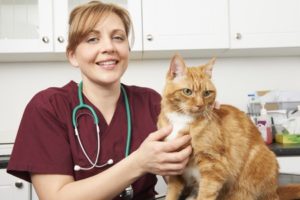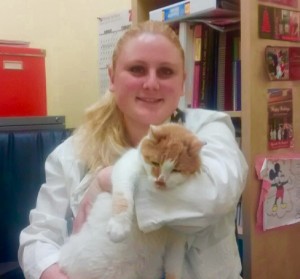Does Your Cat Have Giardia?
 When you own a cat, it’s important to familiarize yourself with the health issues and conditions your feline friend may face. Giardia is one of those conditions. While it is not extremely common, affecting just around 4% of cats that are tested in a vet’s office for the parasite each year, it can have devastating consequences if left untreated. In this post, we’ll discuss what giardia is, how to recognize it, risk factors for infection, and treatment options.
When you own a cat, it’s important to familiarize yourself with the health issues and conditions your feline friend may face. Giardia is one of those conditions. While it is not extremely common, affecting just around 4% of cats that are tested in a vet’s office for the parasite each year, it can have devastating consequences if left untreated. In this post, we’ll discuss what giardia is, how to recognize it, risk factors for infection, and treatment options.
What is Giardia?
Giardia is a microscopic parasite that can cause gastrointestinal issues in cats. This parasite lives in the cat’s intestines and is transmitted through contact with infected feces or contaminated water. infections are more common in areas with poor sanitation and overcrowded living conditions, but even indoor cats can become infected if they come into contact with contaminated substances.
Signs Your Cat May Have Giardia
Giardia infections can vary in severity, and some cats may show no symptoms at all. However, common signs of giardia in cats include:
- Diarrhea
- Weight Loss
- Lethargy
- Vomiting
- Abdominal Discomfort
If your cat is exhibiting any of these symptoms, it’s essential to consult a veterinarian for a proper diagnosis. Left untreated, giardia can lead to dehydration and more severe health issues.
Risk Factors for Giardia
Understanding the risk factors for giardia can help you take preventative measures to protect your cat from this pesky parasite. Several factors can increase the likelihood of your cat contracting giardia, including:
- Water Quality: Drinking contaminated water is a significant risk factor for giardia. Ensure your cat has access to clean, fresh water at all times and avoid letting them drink from potentially contaminated sources.
- Living Conditions & Hygiene: Cats in crowded environments, such as shelters, catteries, or multi-cat households, are more likely to come into contact with infected feces and contaminated surfaces. Additionally, cats who are not well groomed or live in areas that are not properly cleaned and sanitized are at higher risk of infection.
- Outdoor Access: Cats that spend time outdoors have a higher risk of encountering contaminated water sources, such as puddles, streams, or communal water bowls. Outdoor cats may also come into contact with infected animals or their feces.
- Age and Immune Status: Kittens and older cats are more susceptible to giardia due to their weaker immune systems. Similarly, cats with compromised immune systems, whether due to illness or medications, are at higher risk.
- Travel History: Cats that have traveled or been adopted from regions with higher rates of giardia infections may be at an increased risk. These areas often have less stringent sanitation measures, increasing the likelihood of exposure.
- Direct Contact with Infected Animals: Cats that come into direct contact with infected animals, whether through grooming, play, or shared living spaces, are at risk of contracting giardia. It’s essential to isolate infected pets and practice good hygiene to prevent transmission.
Treatment Options for Giardia
Treating giardia in cats involves a multi-faceted approach to eradicate the parasite and prevent reinfection. The primary treatment options include:
- Medications: The most common treatment for giardia is a prescription of antiprotozoal medications such as metronidazole or fenbendazole.
- Hydration: Ensuring your cat stays hydrated is crucial, especially if they are experiencing diarrhea or vomiting. In severe cases of dehydrations, IV fluids might be necessary.
- Environmental Cleaning: Since giardia cysts can survive outside of the feline host, thorough cleaning of your cat’s living areas is essential. This includes washing bedding, litter boxes, and any surfaces your cat frequently contacts with hot, soapy water and disinfectants.
- Preventive Measures: To prevent future infections, it’s essential to keep your cat’s living space clean and free from fecal contamination. Ensure they have access to clean, fresh water and avoid letting them drink from potentially contaminated sources.
Follow-up tests may be required to ensure the infection has been completely eradicated. It’s also advisable to keep infected cats away from other pets to prevent the spread of the parasite.
Giardia Treatment in Tampa Bay at Affordable Pet Hospital
At Affordable Pet Hospital in Tampa Bay, we understand how distressing it can be to see your cat unwell. Our expert team is here to help diagnose and treat giardia, ensuring your feline friend returns to their best self as quickly as possible.
If you suspect your cat may have giardia, don’t hesitate to reach out to us. Schedule an appointment by calling us at 813-991-9898 or request an appointment online through our website. We are dedicated to providing compassionate and effective care to keep all your pets healthy, happy, and disease-free.

 Has your sweet girl been acting a little strange lately? Cats are notoriously difficult to diagnose when they’re ill because they tend to hide their symptoms. However, pregnancy is hard to hide since many of the symptoms cause physical changes. If you notice some or all of the following signs in your kitty, it’s time for a trip to your vet for an
Has your sweet girl been acting a little strange lately? Cats are notoriously difficult to diagnose when they’re ill because they tend to hide their symptoms. However, pregnancy is hard to hide since many of the symptoms cause physical changes. If you notice some or all of the following signs in your kitty, it’s time for a trip to your vet for an  For animal lovers with
For animal lovers with 

